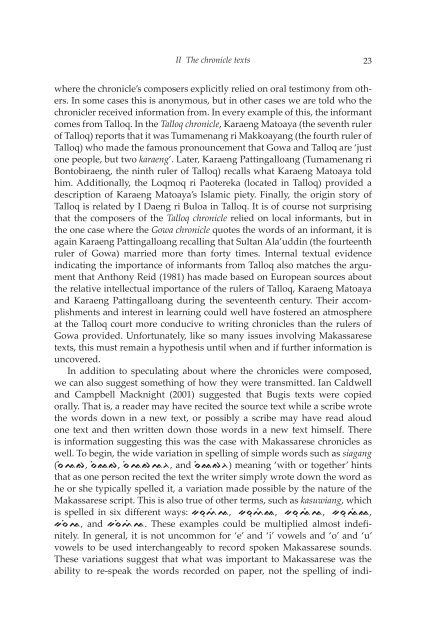A CHAIN OF KINGS - Books and Journals
A CHAIN OF KINGS - Books and Journals
A CHAIN OF KINGS - Books and Journals
You also want an ePaper? Increase the reach of your titles
YUMPU automatically turns print PDFs into web optimized ePapers that Google loves.
II The chronicle texts 23<br />
where the chronicle’s composers explicitly relied on oral testimony from others.<br />
In some cases this is anonymous, but in other cases we are told who the<br />
chronicler received information from. In every example of this, the informant<br />
comes from Talloq. In the Talloq chronicle, Karaeng Matoaya (the seventh ruler<br />
of Talloq) reports that it was Tumamenang ri Makkoayang (the fourth ruler of<br />
Talloq) who made the famous pronouncement that Gowa <strong>and</strong> Talloq are ‘just<br />
one people, but two karaeng’. Later, Karaeng Pattingalloang (Tumamenang ri<br />
Bontobiraeng, the ninth ruler of Talloq) recalls what Karaeng Matoaya told<br />
him. Additionally, the Loqmoq ri Paotereka (located in Talloq) provided a<br />
description of Karaeng Matoaya’s Islamic piety. Finally, the origin story of<br />
Talloq is related by I Daeng ri Buloa in Talloq. It is of course not surprising<br />
that the composers of the Talloq chronicle relied on local informants, but in<br />
the one case where the Gowa chronicle quotes the words of an informant, it is<br />
again Karaeng Pattingalloang recalling that Sultan Ala’uddin (the fourteenth<br />
ruler of Gowa) married more than forty times. Internal textual evidence<br />
indicating the importance of informants from Talloq also matches the argument<br />
that Anthony Reid (1981) has made based on European sources about<br />
the relative intellectual importance of the rulers of Talloq, Karaeng Matoaya<br />
<strong>and</strong> Karaeng Pattingalloang during the seventeenth century. Their accomplishments<br />
<strong>and</strong> interest in learning could well have fostered an atmosphere<br />
at the Talloq court more conducive to writing chronicles than the rulers of<br />
Gowa provided. Unfortunately, like so many issues involving Makassarese<br />
texts, this must remain a hypothesis until when <strong>and</strong> if further information is<br />
uncovered.<br />
In addition to speculating about where the chronicles were composed,<br />
we can also suggest something of how they were transmitted. Ian Caldwell<br />
<strong>and</strong> Campbell Macknight (2001) suggested that Bugis texts were copied<br />
orally. That is, a reader may have recited the source text while a scribe wrote<br />
the words down in a new text, or possibly a scribe may have read aloud<br />
one text <strong>and</strong> then written down those words in a new text himself. There<br />
is information suggesting this was the case with Makassarese chronicles as<br />
well. To begin, the wide variation in spelling of simple words such as siagang<br />
(siag, siyg, siagaG, <strong>and</strong> siygG) meaning ‘with or together’ hints<br />
that as one person recited the text the writer simply wrote down the word as<br />
he or she typically spelled it, a variation made possible by the nature of the<br />
Makassarese script. This is also true of other terms, such as kasuwiang, which<br />
is spelled in six different ways: ksuwia, ksuwiy, ksuaia, ksuaiy,<br />
ksia, <strong>and</strong> ksiwia. These examples could be multiplied almost indefinitely.<br />
In general, it is not uncommon for ‘e’ <strong>and</strong> ‘i’ vowels <strong>and</strong> ‘o’ <strong>and</strong> ‘u’<br />
vowels to be used interchangeably to record spoken Makassarese sounds.<br />
These variations suggest that what was important to Makassarese was the<br />
ability to re-speak the words recorded on paper, not the spelling of indi-









![Am HaSefer [Volk des Buches] - Books and Journals](https://img.yumpu.com/20648352/1/174x260/am-hasefer-volk-des-buches-books-and-journals.jpg?quality=85)







